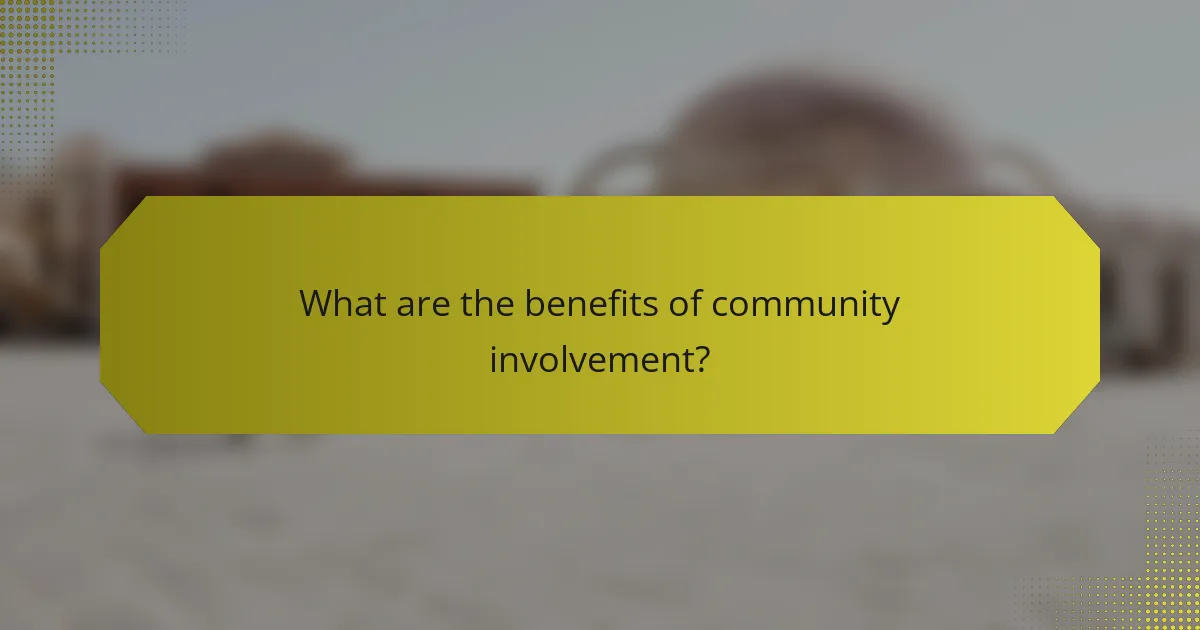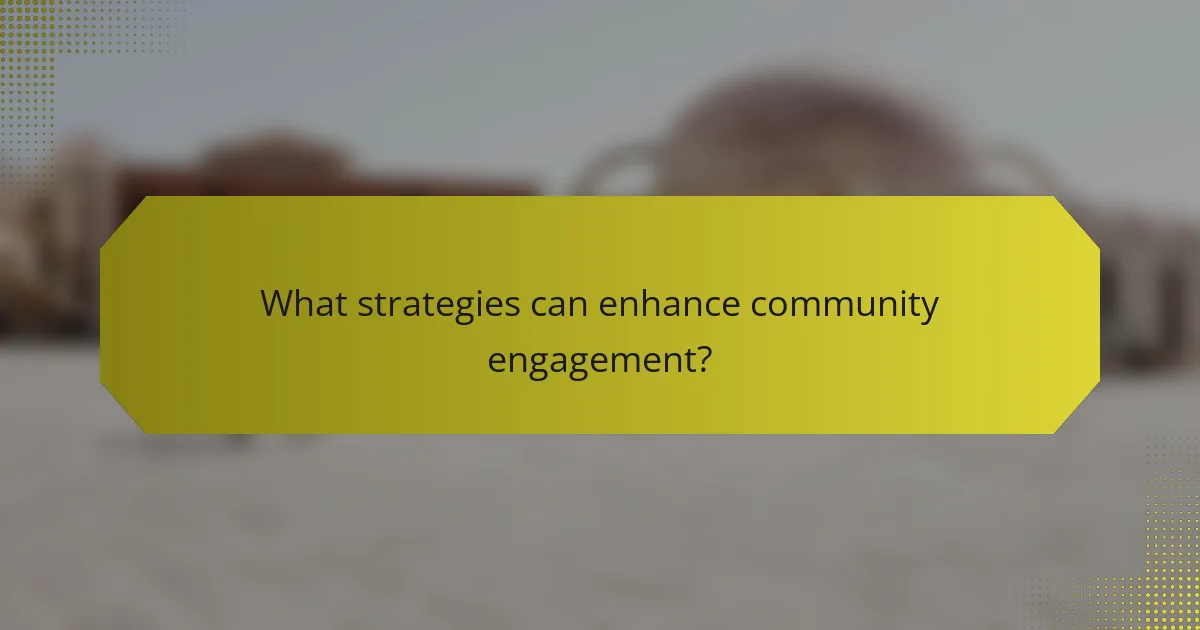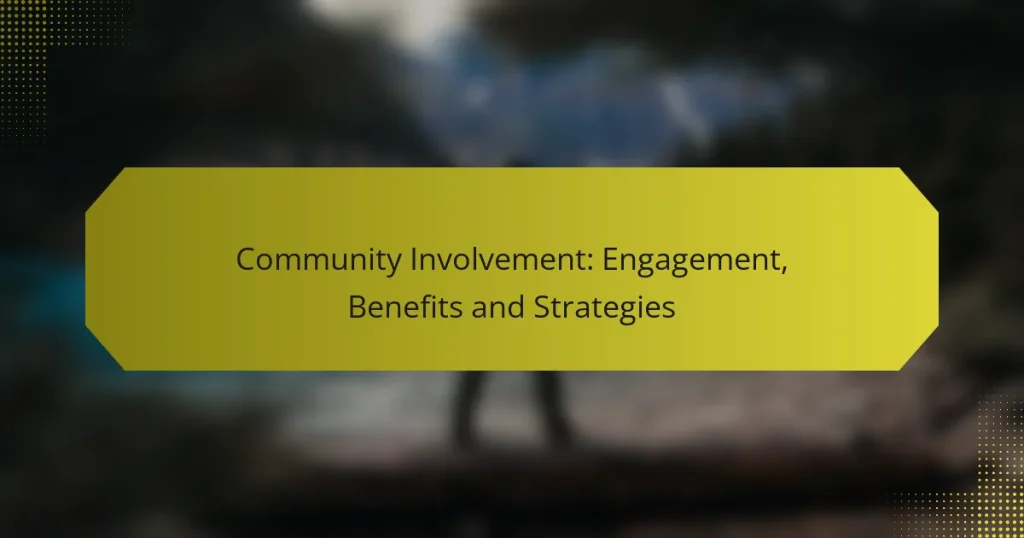Community involvement is essential for fostering strong social ties and enhancing local resources. By engaging residents through open communication and inclusive events, communities can create a collaborative environment that promotes civic engagement and a sense of belonging. Implementing effective strategies not only strengthens community bonds but also contributes to the overall well-being of neighborhoods.

How can communities engage effectively?
Communities can engage effectively by fostering open communication, organizing inclusive events, and creating opportunities for collaboration. These strategies help build relationships, enhance participation, and strengthen community ties.
Community events and workshops
Community events and workshops serve as excellent platforms for engagement, allowing residents to connect over shared interests. Organizing regular events, such as farmers’ markets, art fairs, or educational workshops, can attract diverse groups and encourage participation.
Consider varying the types of events to appeal to different demographics. For example, hosting family-friendly activities, cultural celebrations, or skill-building workshops can enhance community involvement and ensure that everyone feels included.
Online platforms for discussion
Online platforms facilitate discussions and enable community members to share ideas and concerns conveniently. Utilizing social media groups, community forums, or dedicated websites can help gather feedback and foster dialogue among residents.
To maximize effectiveness, ensure that these platforms are user-friendly and accessible. Regularly engaging with participants by responding to comments and sharing updates can maintain interest and encourage ongoing interaction.
Volunteer opportunities
Offering volunteer opportunities is a powerful way to engage community members while addressing local needs. Organizing clean-up drives, mentoring programs, or food drives can motivate residents to contribute their time and skills.
Promote these opportunities through local newsletters, social media, and community boards. Highlight the impact of volunteering on both the community and the volunteers themselves to inspire participation.
Partnerships with local businesses
Establishing partnerships with local businesses can enhance community engagement by leveraging resources and expertise. Collaborations can include sponsorships for events, joint marketing efforts, or providing venues for community gatherings.
When forming these partnerships, ensure mutual benefits are clear. For instance, businesses can gain visibility and goodwill, while the community can access resources and support for various initiatives.

What are the benefits of community involvement?
Community involvement offers numerous benefits, including stronger social ties, enhanced local resources, and increased civic engagement. By participating in community activities, individuals can foster a sense of belonging while contributing to the overall well-being of their neighborhoods.
Enhanced social connections
Engaging in community activities helps build relationships among residents, creating a network of support and friendship. These social connections can lead to improved mental health, as individuals feel more connected and less isolated.
Participating in local events, volunteering, or joining clubs can facilitate interactions that strengthen these bonds. Consider attending neighborhood meetings or community workshops to meet new people and expand your social circle.
Improved local resources
Community involvement often leads to better local resources, as residents collaborate to identify needs and advocate for improvements. This can include enhancing public facilities, parks, and services that benefit everyone in the area.
For example, a community group might organize a fundraising event to renovate a local playground or establish a community garden. These initiatives not only enhance resources but also encourage collective ownership and pride among residents.
Increased civic participation
When individuals engage in their communities, they are more likely to participate in civic activities such as voting, attending town hall meetings, or advocating for local issues. This heightened civic engagement can lead to more responsive governance and policies that reflect the community’s needs.
To boost civic participation, consider joining local advocacy groups or attending public forums. Staying informed about local issues and encouraging others to engage can create a more active and informed citizenry.
Boosted local economy
Community involvement can significantly impact the local economy by fostering support for local businesses and initiatives. When residents engage with their community, they are more likely to shop locally and support neighborhood enterprises.
Participating in community events, such as farmers’ markets or local festivals, can stimulate economic growth. Additionally, volunteering for local organizations can help create job opportunities and enhance skills within the community, further benefiting the local economy.

What strategies can enhance community engagement?
Effective community engagement strategies focus on building relationships and fostering participation among residents. By utilizing various methods, communities can create a more inclusive and active environment that benefits everyone involved.
Utilizing social media campaigns
Social media campaigns can significantly boost community engagement by reaching a wider audience and encouraging interaction. Platforms like Facebook, Instagram, and Twitter allow for real-time communication and sharing of community events, initiatives, and updates.
To implement an effective campaign, consider creating engaging content that resonates with your audience, such as videos, polls, or local success stories. Regularly monitor engagement metrics to adjust your strategy as needed and ensure that your messaging aligns with community interests.
Creating inclusive programs
Inclusive programs are essential for ensuring that all community members feel valued and represented. This can involve organizing events that cater to diverse groups, such as cultural festivals, workshops, or support groups that address specific needs.
When designing these programs, actively seek input from various community segments to understand their preferences and barriers to participation. This approach not only fosters a sense of belonging but also enhances the overall effectiveness of community initiatives.
Implementing feedback mechanisms
Feedback mechanisms are crucial for understanding community needs and improving engagement efforts. Surveys, suggestion boxes, and community meetings can provide valuable insights into residents’ opinions and experiences.
To maximize participation, ensure that feedback channels are accessible and user-friendly. Regularly communicate how community input is being used to shape programs and initiatives, reinforcing the value of resident contributions.
Developing community leadership roles
Establishing community leadership roles empowers residents to take an active part in local decision-making. This can include forming committees or task forces that focus on specific issues, such as public safety, education, or environmental sustainability.
Encourage diverse representation within these leadership roles to reflect the community’s demographics. Providing training and resources for emerging leaders can enhance their effectiveness and foster a culture of collaboration and shared responsibility.

What are the prerequisites for successful community projects?
Successful community projects require a clear understanding of local needs and strong relationships with stakeholders. These elements ensure that initiatives are relevant, supported, and sustainable over time.
Identifying community needs
Identifying community needs involves engaging with residents to understand their priorities and challenges. This can be achieved through surveys, focus groups, or public meetings, allowing for a diverse range of voices to be heard.
Consider using tools like SWOT analysis (Strengths, Weaknesses, Opportunities, Threats) to assess the community’s current situation. This structured approach helps pinpoint specific areas where projects can make a significant impact.
Regularly revisiting these needs is crucial, as community dynamics can shift. Aim to conduct assessments at least annually to stay aligned with evolving priorities.
Building stakeholder relationships
Building strong relationships with stakeholders is essential for the success of community projects. Stakeholders can include local government, non-profits, businesses, and community leaders who can provide resources and support.
Start by identifying key stakeholders and understanding their interests and motivations. Establish open lines of communication and involve them early in the planning process to foster collaboration and buy-in.
Regular updates and transparent reporting on project progress can help maintain these relationships. Consider organizing quarterly meetings or newsletters to keep stakeholders informed and engaged, ensuring their continued support.

How do successful communities measure engagement?
Successful communities measure engagement through various methods that provide insights into member participation and satisfaction. Key metrics often include participation rates, feedback quality, and the frequency of interactions among members.
Surveys and feedback forms
Surveys and feedback forms are essential tools for gauging community engagement. They allow members to express their opinions and experiences, providing valuable data that can inform community strategies. Regularly conducting surveys can help identify areas for improvement and highlight successful initiatives.
When designing surveys, keep questions clear and concise. Use a mix of quantitative questions, like rating scales, and qualitative questions that invite open-ended responses. Aim for a completion time of under 10 minutes to encourage higher response rates.
Consider incentivizing participation with small rewards, such as gift cards or community recognition. This approach can boost response rates and demonstrate that member feedback is valued. Always analyze the results and share key findings with the community to foster transparency and trust.


